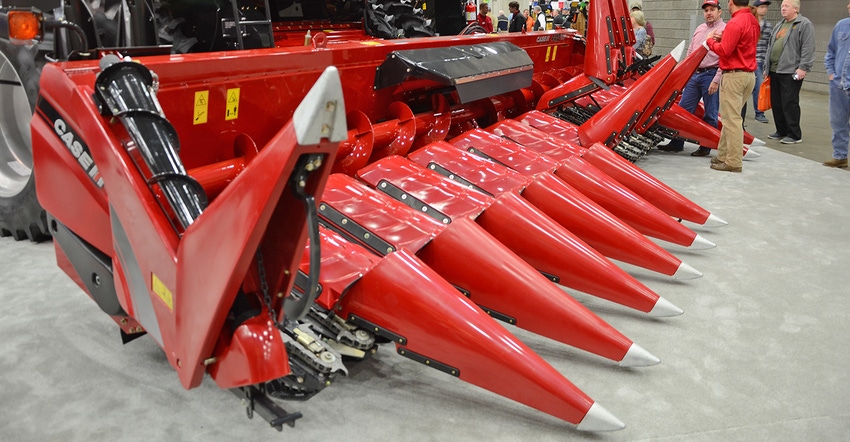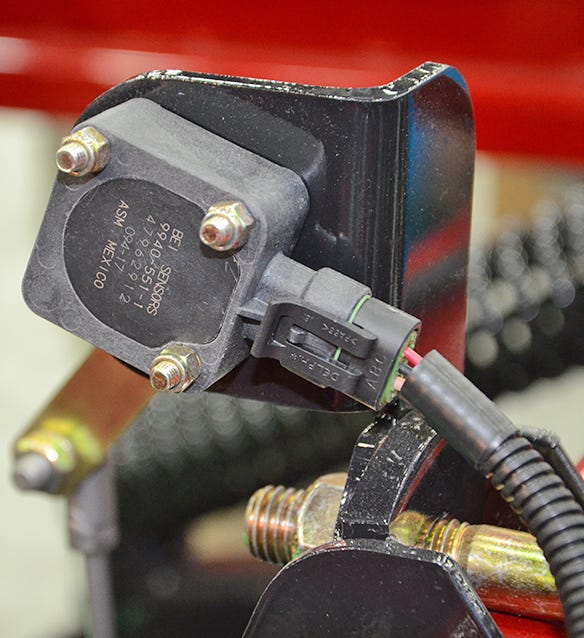February 26, 2018

It’s easy sometimes at a farm show to concentrate on the new technology, and there was plenty of that on hand at the National Farm Machinery Show earlier this year. For Case IH, the introduction included a blend of new tech and key innovations to meet customer needs. Here’s a rundown of a few tools launched at the show.
The rising trend for farmers to plant corn in narrow rows to boost in-field populations is driving the introduction of the 4400 Series narrow-row corn heads. Kelly Kravig, Case IH marketing manager for combines and corn heads, explains that this head has been designed from the ground up for narrow-row use.
“This corn head is available in 12-, 16- and 18-row configurations in either 20- or 22-inch widths,” he says. “The first thing a farmer wants is a head that picks clean, and these units do that.” To get that done, he notes that the snap rolls work with the divider hoods and the row units to move corn into the feeder house.
He adds that farmers also want to pick cleaner, and the new heads allow that by boosting corn head capacity. The redesigned head is designed to save more grain with a design that includes new dividers to the opening of the feeder house.
“You can even pick down corn with these row units because they sweep the corn into the stalk roll,” he says. “And we’ve reduced the weight of these heads to improve combine flotation.”
Company engineers were able to shave head weight by 100 pounds per row, along with some other savings — that’s 2,000 pounds on the 18-row machine, Kravig says.
Power flow has been redesigned as well. Power is driven from gearboxes in the center of the header and split equally to the right and left side. Kravig explains this boosts power flow and provides a cleaner design.

SMART SENSOR: Soil Command relies on this smart sensor to help create a truly level seedbed below the soil surface. The user sets the level, and can tweak it during seedbed prep for best results.

Smarter tillage
Seedbed prep is becoming a hot topic. Are you creating a level place for seed to rest belowground when you’re done with tillage?
The company is launching Soil Command for the Tiger Mate 255 field cultivator. This innovative system uses a sensor on each shank section to control angle, depth and orientation of shanks going through the field.
“With this system you can be more assured you’re getting a level seedbed,” says Chris Lursen, Case IH tillage marketing manager. “For high-efficiency farming, we want to be sure we have a good, level seedbed when we finish tillage.”
The sensor knows the position of the shank. The operator can move through the field and check readings, and make adjustments during seedbed prep. The system is not yet automatic, but that could come later. For now, the system reports position to the AFS Pro 700 monitor, noting when the seedbed is uneven, and allows the user to make adjustments.

Case IH has pulled together a chart showing how it defines farm automation. This helps when talking about new product advancements with customers. The company is entering into an in-field test of its cab-less tractor for 2018.

Defining automation
Just what is automation in agriculture? In the automotive world, the Society of Automotive Engineers has defined different levels, but what about agriculture?
Brad Lukac, director, autonomous vehicles, CNH, shares that the company has pulled together a six-phase look at the different levels of automation. The chart on this page shows those levels.
“We’re keen on defining how this evolves to the future,” Lukac says. “We want to know what automation will look like for the future.”
Case IH made waves in 2016 when it debuted a cab-less tractor at the Farm Progress Show. Work on that machine continues. But those six levels of “automation,” progressing from simple guidance all the way to full autonomy with remote supervision (see the chart), offer a look at how the company sees automation.
“There are different ways for autonomy to evolve, including supervised autonomy with someone in the field while machines do the work,” he says. “Or they could be in one machine as another works, too, with both machines being autonomous.” This is an evolving area of engineering.
However, Case IH did announce that the company will be working on an autonomous trial with Bolthouse Foods in California in 2018. The carrot company, known for both fresh carrots and its juice line, is owned by Campbell Soup.
The pilot program will focus on primary tillage and deep tillage — two repetitive tasks that the operation conducts year-round. There will be no cab-less tractors in this trial; instead, it will be a small fleet of autonomous Steiger Quadtrac tractors, pulling either a True Tandem disk harrow or an Ecolo-Tiger disk ripper. The test will help evaluate how these systems work in a range of conditions, soil types and weather.
Learn more about the new products at caseih.com.
About the Author(s)
You May Also Like






